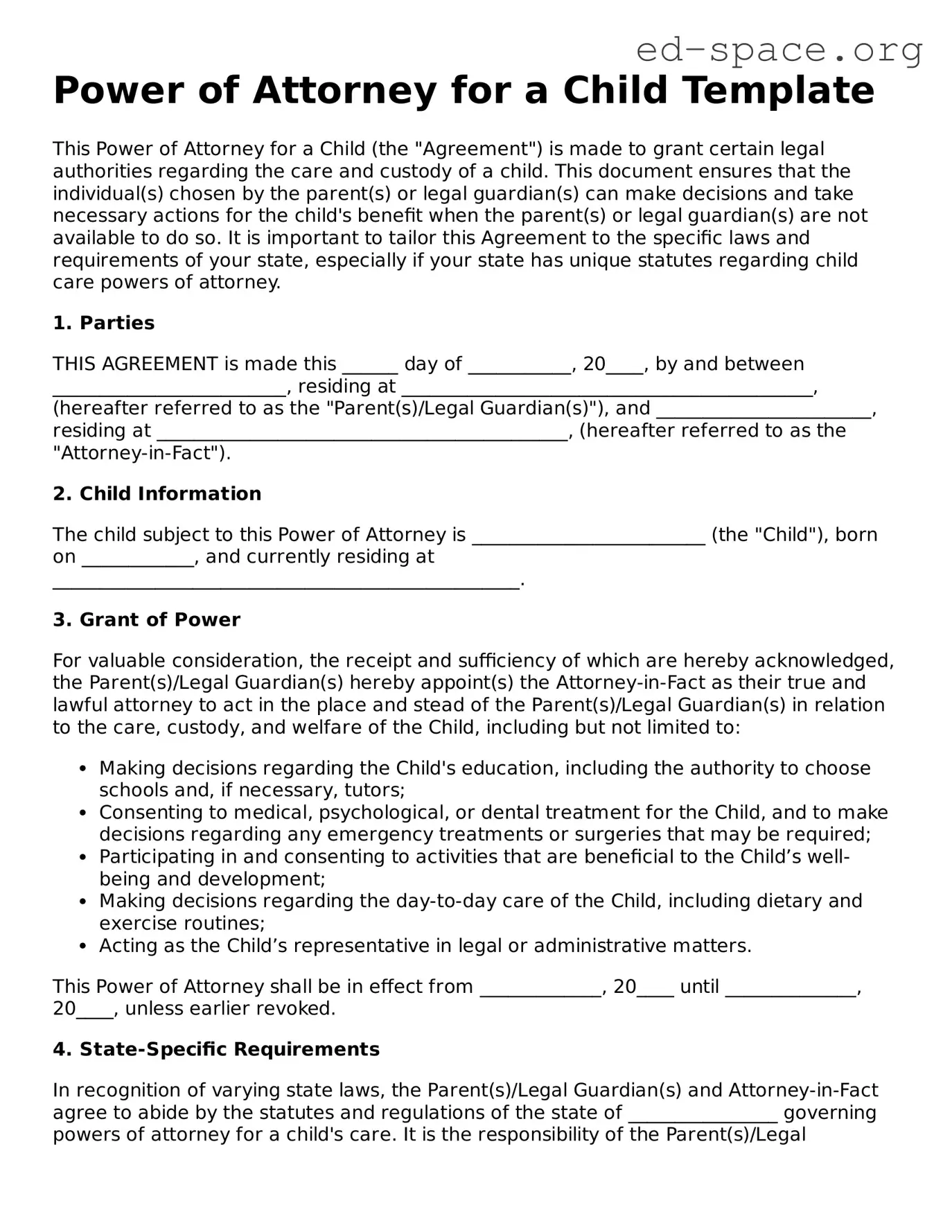Power of Attorney for a Child Template
This Power of Attorney for a Child (the "Agreement") is made to grant certain legal authorities regarding the care and custody of a child. This document ensures that the individual(s) chosen by the parent(s) or legal guardian(s) can make decisions and take necessary actions for the child's benefit when the parent(s) or legal guardian(s) are not available to do so. It is important to tailor this Agreement to the specific laws and requirements of your state, especially if your state has unique statutes regarding child care powers of attorney.
1. Parties
THIS AGREEMENT is made this ______ day of ___________, 20____, by and between _________________________, residing at ____________________________________________, (hereafter referred to as the "Parent(s)/Legal Guardian(s)"), and _______________________, residing at ____________________________________________, (hereafter referred to as the "Attorney-in-Fact").
2. Child Information
The child subject to this Power of Attorney is _________________________ (the "Child"), born on ____________, and currently residing at __________________________________________________.
3. Grant of Power
For valuable consideration, the receipt and sufficiency of which are hereby acknowledged, the Parent(s)/Legal Guardian(s) hereby appoint(s) the Attorney-in-Fact as their true and lawful attorney to act in the place and stead of the Parent(s)/Legal Guardian(s) in relation to the care, custody, and welfare of the Child, including but not limited to:
- Making decisions regarding the Child's education, including the authority to choose schools and, if necessary, tutors;
- Consenting to medical, psychological, or dental treatment for the Child, and to make decisions regarding any emergency treatments or surgeries that may be required;
- Participating in and consenting to activities that are beneficial to the Child’s well-being and development;
- Making decisions regarding the day-to-day care of the Child, including dietary and exercise routines;
- Acting as the Child’s representative in legal or administrative matters.
This Power of Attorney shall be in effect from _____________, 20____ until ______________, 20____, unless earlier revoked.
4. State-Specific Requirements
In recognition of varying state laws, the Parent(s)/Legal Guardian(s) and Attorney-in-Fact agree to abide by the statutes and regulations of the state of ________________ governing powers of attorney for a child's care. It is the responsibility of the Parent(s)/Legal Guardian(s) and Attorney-in-Fact to ensure that this Agreement complies with state laws and to amend it as necessary to meet those requirements.
5. Revocation
The Parent(s)/Legal Guardian(s) may revoke this Power of Attorney at any time by providing written notice to the Attorney-in-Fact. This Agreement automatically terminates upon the expiration date set forth above, or upon the death of the Parent(s)/Legal Guardian(s), the Attorney-in-Fact, or the Child, whichever occurs first.
6. Signatures
IN WITNESS WHEREOF, the parties have executed this Power of Attorney for a Child as of the day and year first written above.
Parent(s)/Legal Guardian(s) Signature: ___________________________________
Date: __________________
Attorney-in-Fact Signature: __________________________________________
Date: __________________
7. Notarization
If required by state law or desired by the parties, the signatures on this document may be notarized to provide additional legal validity and to authenticate this Power of Attorney for a Child.
